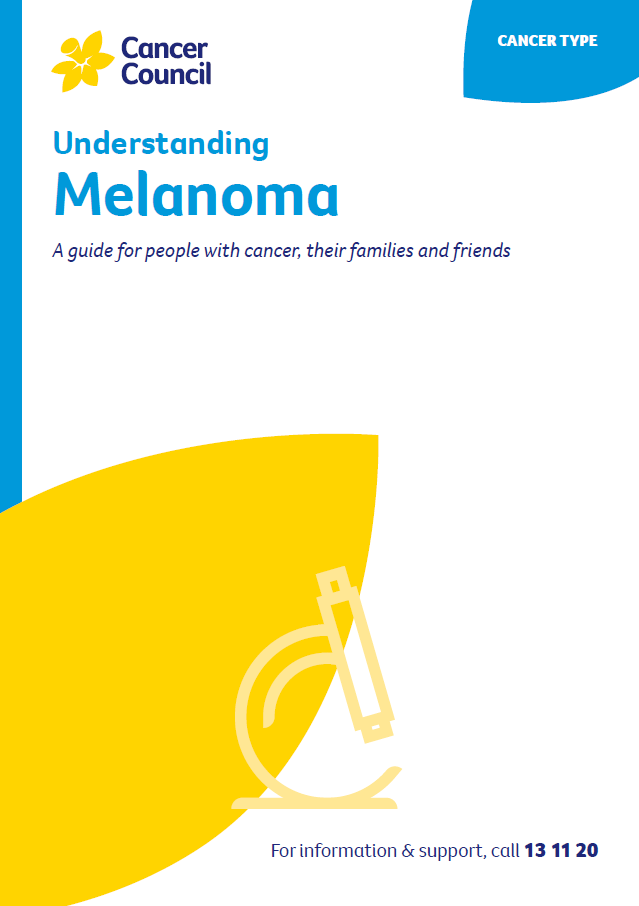- Home
- Melanoma
- Treatment for early melanoma
- Surgery
Surgery for melanoma
Surgery to remove the mole is the main treatment for early melanoma, and it can also be the only treatment you need.
Learn more about:
- Surgery (wide local excision)
- Checking for a clear margin
- Repairing the wound
- What to expect after surgery
Surgery (wide local excision)
| What is a wide local excision? | After an excision biopsy, most people diagnosed with melanoma will require a second surgery to remove more skin from around the melanoma. This is known as a wide local excision and is the main treatment for early melanoma. |
| Why is more skin removed? | Removing more skin around the melanoma reduces the risk of it coming back (recurring) at that site. The width of the margin is usually 5–10 mm, depending on the type, thickness and location of the melanoma. For thicker tumours, or tumours with certain characteristics, a wider margin of up to 20 mm may be advised. |
| How the procedure is performed | A wide local excision is often performed as a day procedure, so you can go home soon after the surgery if there are no complications. If the melanoma is thicker than 1 mm or is considered to have a high risk of spreading to the lymph nodes, the doctor will discuss the risks and benefits of having a sentinel lymph node biopsy. If you need a sentinel node biopsy, it is done at the same time as the wide local excision. |
Learn more about surgery.
Checking for a clear margin
After a wide local excision, the tissue removed from around the melanoma will be sent to a laboratory. The pathologist will check that the required margin has been taken – this is called a clear margin. If the margins need to be wider, you may need to have further surgery to remove more tissue.
Repairing the wound
The wound is often closed with stitches. You will have a scar but this will usually become less noticeable with time. If a large area of skin is removed, the surgeon may repair the wound using skin from another part of your body.
This can be done in 2 ways:
- Skin flap – Nearby skin and fatty tissue are lifted and moved over the wound from the edges and stitched.
- Skin graft – A layer of skin is taken from another part of your body (most often the thigh or neck) and placed over the area where the melanoma was removed. The skin grows back quickly, usually over a few weeks.
Whether the surgeon does a skin flap or graft will depend on a number of factors, including:
- where the melanoma was
- how much tissue has been removed.
In either case, the wound will be covered with a dressing. After several days, the doctor will check to see if the wound is healing properly.
If you had a skin graft, you will also have a dressing on any area that had skin removed for the graft.
What to expect after surgery
Most people recover quickly after a wide local excision to remove a melanoma, but you will need to keep the wound clean.
 | Pain reliefThe area around the wide local excision may feel tight and tender for a few days. Your doctor will prescribe pain medicine if necessary. |
 | Wound careYour treatment team will tell you how to keep the wound clean to prevent it from becoming infected. Occasionally, the original skin flap or graft doesn’t heal. In this case, you will need to either have a dressing on the wound for longer or have another procedure to create a new flap or graft. |
Skin changesIf you have a skin graft, the area that had skin removed may look red and raw immediately after the operation. Over a few weeks to months, this area will heal, and the redness will fade. | |
Recovery timeThe time it takes to recover will vary depending on the thickness of the melanoma and how much surgery was required. Most people recover in 1–2 weeks. Ask your doctor how long to wait before returning to your usual exercise and activities. | |
 | When to seek adviceTalk to your doctor if you have any unexpected bleeding, bruising, infection, scarring or numbness after surgery. |
Surgery for melanoma often leaves a scar, but this usually fades with time. If you’re worried about how the scar looks, you can use cosmetics, hairstyles and clothing to help cover the scar. Look Good Feel Better is a national program that helps people manage appearance-related effects of cancer treatment. For information about workshops in your area, call 1800 650 960 or visit Look Good Feel Better.
After the wide local excision, the wound looked red and was sore, but this improved within four weeks.
Pete
→ READ MORE: Removing lymph nodes
Podcast: Making Treatment Decisions
Listen to more episodes from our podcast for people affected by cancer
More resources
A/Prof Rachel Roberts-Thomson, Medical Oncologist, The Queen Elizabeth Hospital, SA; A/Prof Robyn Saw, Surgical Oncologist, Melanoma Institute Australia, Royal Prince Alfred Hospital and The University of Sydney, NSW; Alison Button-Sloan, Consumer; Dr Marcus Cheng, Radiation Oncologist Registrar, Alfred Health, VIC; Prof Anne Cust, Deputy Director, The Daffodil Centre, The University of Sydney and Cancer Council NSW, Chair, National Skin Cancer Committee, Cancer Council, and faculty member, Melanoma Institute Australia; Prof David Gyorki, Surgical Oncologist, Peter MacCallum Cancer Centre, VIC; Dr Rhonda Harvey, Mohs Surgeon, Dermatologist, Green Square Dermatology, The Skin Hospital, Darlinghurst and Sydney Melanoma Diagnostic Centre, RPA, NSW; David Hoffman, Consumer; A/Prof Jeremy Hudson, Southern Cross University, James Cook University, Chair of Dermatology RACGP, Clinical Director, North Queensland Skin Cancer, QLD; Dr Damien Kee, Medical Oncologist, Austin Health and Peter MacCallum Cancer Centre and Clinical Research Fellow, Walter & Eliza Hall Institute, VIC; Angelica Miller, Melanoma Community Support Nurse, Melanoma Institute Australia, WA; Romy Pham, 13 11 20 Consultant, QLD; A/Prof Sasha Senthi, Radiation Oncologist, Alfred Health, and Clinical Research Fellow, Victorian Cancer Agency, VIC; Dr Chistoph Sinz, Dermatologist, Melanoma Institute Australia, NSW; Dr Amelia Smit, Research Fellow, Melanoma and Skin Cancer, The Daffodil Centre, The University of Sydney and Cancer Council NSW; Nicole Taylor, Clinical Nurse Consultant, Crown Princess Mary Cancer Centre, Westmead Hospital, NSW.
View the Cancer Council NSW editorial policy.
View all publications or call 13 11 20 for free printed copies.

